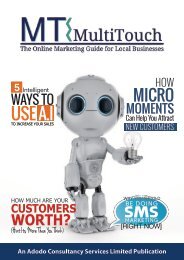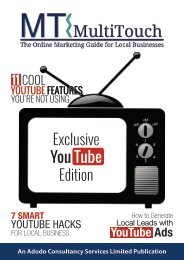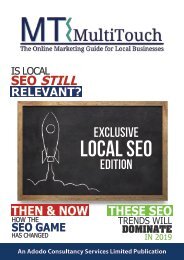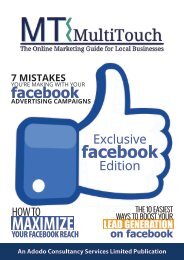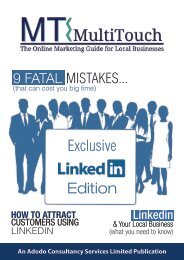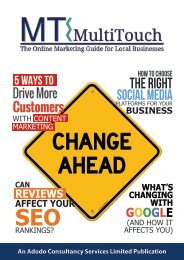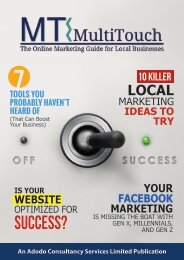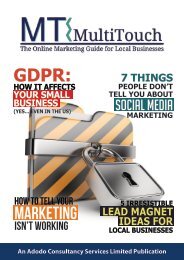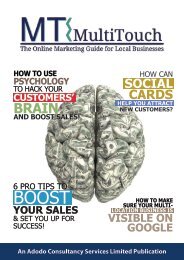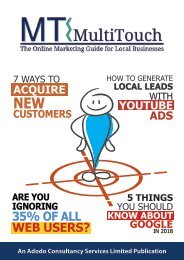mt-magazine-issue-Feb18
You also want an ePaper? Increase the reach of your titles
YUMPU automatically turns print PDFs into web optimized ePapers that Google loves.
7 SMART<br />
WAYS TO<br />
GROW YOUR<br />
EMAIL<br />
LIST<br />
HOW TO<br />
INCREASE<br />
SALES ON A<br />
SHOESTRING<br />
BUDGET<br />
HOW TO<br />
GET MORE<br />
CUSTOMER<br />
REFERRALS<br />
WHAT’S THE<br />
DEFINITION<br />
OF A GOOD<br />
WEBSITE?<br />
An Adodo Consultancy Services Limited Publication
Contents<br />
7 Smart Ways to Grow Your<br />
Email List 03<br />
Email marketing is where it’s at. It<br />
might not be the new, sparkly toy in<br />
your marketing tool box, but email<br />
dominates when it comes to ROI.<br />
In fact, email marketing earns an<br />
average of $40 for every $1 spent. Let’s face it, that’s the ROI that<br />
marketing dreams are made of. Here’s the thing. Growing your list<br />
doesn’t have to cost you a ton of money. We’ll reveal 7 smart ways<br />
to attract new subscribers.<br />
How to Get More Customer<br />
Referrals<br />
08<br />
You want to attract more business. But<br />
if you’re thinking that the best way<br />
to get it is through paid advertising,<br />
think again. The truth is that word of<br />
mouth advertising is still worth its<br />
weight in gold. Referrals from friends and colleagues carry even<br />
more weight. In fact, they convert 30% more often than leads<br />
that come from other sources so let’s talk about some simple<br />
things you can do to get more customer referrals.<br />
How to Increase Sales on a<br />
Shoestring Budget<br />
13<br />
You’ve got to spend money to make<br />
money. Right? Well… maybe. Many<br />
of the tried and true marketing tricks<br />
you read about do require a substantial<br />
budget. But some don’t. It’s all<br />
about getting creative and taking chances with your marketing<br />
where it makes sense to do so. So, with that in mind, here are<br />
some super-effective marketing tricks that can help you grow<br />
your sales without blowing through your (small) budget.<br />
What’s the Definition of a GOOD<br />
Website?<br />
18<br />
Most businesses these days have a<br />
website. But is that enough to make<br />
your business a success? Is it enough<br />
to help your business grow and thrive?<br />
The problem is that a lot of entrepreneurs<br />
and business owners don’t know what goes into creating<br />
a good website – good. So, with that in mind, let’s take a few<br />
minutes to define what makes a website good. Once you know,<br />
you can create the kind of website that converts more visitors<br />
and attracts new customers.<br />
Welcome To MT<br />
Thanks for checking out the latest<br />
edition of MT, your online marketing<br />
resource guide for local businesses.<br />
Each month we will be covering topics<br />
that resonate with local businesses<br />
just like yours.<br />
Our goal is simple. We want to<br />
enable you to do big things online,<br />
and it all starts by breaking down<br />
the complexities of marketing your<br />
business online.<br />
It doesn’t matter if you are just starting<br />
out, or an established business owner<br />
in your local community, you can<br />
always benefit from increasing your<br />
brand’s visibility online.<br />
To your Success,<br />
Tim Glynn<br />
CEO and head of fun<br />
MT IS BROUGHT TO YOU BY<br />
Adodo Consultancy Services, the leading<br />
small business marketing service dedicated<br />
to putting reputation marketing at the heart<br />
of a local businesses marketing strategy. We<br />
help small businesses connect with more<br />
customers online.<br />
If you want to build your business, you need<br />
to market, it’s that simple. But you can lose<br />
thousands of dollars if you don’t know what<br />
you are doing. So we urge you to take action<br />
with some of the strategies we recommend.<br />
Feel free to reach out to us at any time.
7 SMART WAYS TO<br />
GROW YOUR EMAIL LIST<br />
Email marketing is where it’s at. It might not be the new, sparkly toy in your marketing tool box,<br />
but email kills when it comes to ROI. In fact, email marketing earns an average of $40 for every<br />
$1 spent.<br />
Let’s face it, that’s the ROI that marketing dreams are made of. And it points to what amounts to<br />
a missed opportunity for many businesses. If you’re not actively growing your email list, you’re<br />
missing out on one of the best, most cost-effective ways to grow your business.<br />
And here’s the thing. Growing your list doesn’t have to cost you a ton of money. Here are 7 smart<br />
ways to attract new subscribers.
#1:<br />
ADD A SIGN-UP BUTTON TO<br />
YOUR FACEBOOK PAGE<br />
Let’s start with an option that’s free and takes only<br />
minutes to do. Facebook now allows businesses to<br />
add a Call to Action button on their page. There are<br />
six choices, but the one we’re focusing on today is<br />
the “Sign Up” button.<br />
The button shows up on the right-hand side of the<br />
page just beneath your cover photo. Clicking it will<br />
redirect visitors to a URL you provide. In this case, it<br />
should be your opt-in page. That’s where you can<br />
display information about your list and ask people to<br />
fill out the opt-in form.<br />
lines at the top to tell people why they<br />
should subscribe to your list. For example,<br />
saying “Sign up here to be the first<br />
to know about our upcoming sales and<br />
promotions,” people will understand<br />
what they’re getting. Even better, they’ll<br />
be eager to sign up.<br />
An alternative, of course, is to have your<br />
cashiers or other staff ask people for their<br />
email addresses when they check out.<br />
On a related note, you can run a Facebook ad with a<br />
“Sign Up” button too, and it will do the same thing. If<br />
you choose the ad, you’ll have to pay for it. But, it’s a<br />
cost-effective way to attract new subscribers.<br />
#2:<br />
HAVE A PAPER SIGN-UP<br />
SHEET AT YOUR BUSINESS<br />
Our next trick is an old-school method to attract subscribers.<br />
People who walk into your business may be<br />
willing to take a minute to provide you with their<br />
name and email address if you make it easy for them<br />
to do. And what’s easier than a paper sign-up sheet?<br />
If you choose this option, make sure to include a few
#3:<br />
ALLOW PEOPLE TO SUBSCRIBE<br />
VIA TEXT MESSAGE<br />
One of the biggest obstacles businesses must overcome<br />
when attracting subscribers is the inconvenience<br />
factor. People don’t want to waste their time<br />
filling out a lengthy or complicated form. So, why<br />
not let them text to subscribe?<br />
Some email marketing providers are now offering a<br />
text to subscribe option. It allows mobile users to text<br />
the word “subscribe” to them, and they’ll be added to<br />
your email list. What we love about this method is<br />
that it takes only seconds to do.<br />
The great thing about this option is that you’ll probably<br />
need to ask people for their email addresses<br />
anyway. You may need it to send them tickets or updates<br />
about the event. Simply adding a<br />
checkbox to your event sign-up form<br />
makes it a snap for attendees to opt-in to<br />
your list at the same time.<br />
The key here is to make sure you describe<br />
your list briefly, so people know<br />
what they’re signing up for. You want to<br />
make it seem like a no-brainer for people<br />
to tick that box.<br />
This option works by creating a custom code for new<br />
subscribers to use. To make it even easier, you can<br />
display a sign in your store with the code so people<br />
can see it and act on it immediately.<br />
#4:<br />
COLLECT EMAIL ADDRESSES WHEN<br />
YOU’RE PLANNING AN EVENT<br />
Do you host events for your business? Whether<br />
you’re putting together a charity fundraiser or a<br />
gala opening, you can use the opportunity to collect<br />
email addresses and grow your list.
#5:<br />
CREATE AN IRRESISTIBLE<br />
LEAD MAGNET<br />
The idea of creating a lead magnet isn’t new –<br />
but if you aren’t doing it, it’s new to you. A lead<br />
magnet, in case you don’t know, is a freebie you<br />
give people to entice them to subscribe to your<br />
list.<br />
The key is to create a lead magnet that appeals<br />
directly to your target audience. Then, you need<br />
to sell it hard. Outline the primary benefits that<br />
subscribers will get if they opt in. The more enticing<br />
your lead magnet is, the more likely it is<br />
that it will help you supersize your list.<br />
One option that I really like is the scroll-triggered<br />
form. Instead of putting your form above<br />
the fold, as many marketing experts tell you to<br />
do, show it to site visitors after they’ve had a<br />
chance to read some of your fantastic content.<br />
A form that shows up at the right time can catch<br />
readers when they’re impressed with your expertise<br />
and grateful for what they’ve learned by<br />
reading your content. At that point, they’ll be<br />
happy to give you’re their email address in return.<br />
Keep in mind that a lead magnet doesn’t have<br />
to be worth a lot to be worthwhile. A well-designed<br />
tip sheet or template may be just the<br />
thing to bring in a slew of new subscribers.<br />
#6:<br />
GET CREATIVE WITH YOUR<br />
SIGN-UP FORM<br />
You don’t necessarily need a dedicated opt-in page to get<br />
people to subscribe to your list. Sometimes, it’s enough to create<br />
the perfect opt-in form – and place it perfectly on your page.
#7:<br />
USE GUEST WI-FI TO<br />
COLLECT ADDRESSES<br />
Do you allow guests to access your wi-fi? If so, adding a gateway to their access can make it easy<br />
to collect email addresses.<br />
Instead of just giving guests the password, add a field to the form and request their email address<br />
as well. Even if you make the email field optional, most guests will be happy to provide their email<br />
address to use your wi-fi.<br />
USE GUEST WI-FI TO COLLECT ADDRESSES<br />
Instead, use these seven smart and easy ways to attract new subscribers. Once they’re on your<br />
list, you can wow them with a well-designed drip campaign that will convert them into paying<br />
customers.
HOW TO GET MORE<br />
CUSTOMER REFERRALS<br />
You want more business. That’s a<br />
no-brainer! But if you’re thinking that<br />
the best way to get it is through paid<br />
advertising, think again.<br />
The truth is that even in this electronic<br />
age, word of mouth advertising is<br />
worth its weight in gold. That’s why<br />
online reviews are important. 97% of all<br />
consumers read online reviews prior<br />
to patronizing a business – and most<br />
often, they’re reviews from strangers.<br />
Referrals from friends and colleagues<br />
carry even more weight. In fact, they<br />
convert 30% more often than leads<br />
that come from other sources.<br />
That’s why you need to set up a referral<br />
program to encourage customers<br />
to send their friends to you.<br />
But wait… won’t happy customers<br />
just refer their friends as a matter of<br />
course?<br />
Some might – but most won’t. You need<br />
to ask. So, let’s talk about some simple<br />
things you can do to get more customer<br />
referrals.
Step #1: Identify Potential Referral Sources<br />
Referrals can come from many places.<br />
Before you decide on the parameters<br />
of your new referral program, you’ll<br />
need to think about who can provide<br />
you with the kind of qualified leads you<br />
want. Here’s a run-down of the most<br />
likely sources:<br />
1. Existing customers and clients are<br />
a great source of referrals. They<br />
know you and your products, and<br />
that makes them uniquely qualified<br />
to point likely customers your way.<br />
2. Employees are another potential<br />
referral source. Like your customers,<br />
they know the company and what<br />
it does. They can also provide<br />
potential leads with detailed<br />
information about the benefits of<br />
working with you.<br />
3. Vendors may be a source of<br />
referral business. They know what<br />
it’s like to work with you. Even if<br />
their experience is with a different<br />
side of the business than what<br />
customers would see, they can<br />
still talk about your products and<br />
services knowledgeably.<br />
4. Joint venture partners are another<br />
potential source of referrals. These<br />
arrangements may have a quid pro<br />
quo element to them, but they can<br />
be very effective.<br />
5. Finally, don’t forget your friends<br />
and family. Even if they’re not<br />
customers, they can still point<br />
people in your direction when the<br />
opportunity arises.<br />
The techniques you use to attract<br />
more referral business are similar<br />
regardless of the source you focus<br />
on. Now, let’s talk about what to do to<br />
attract referrals.
Ask for Referrals<br />
The first and most obvious way to get<br />
referrals is to ask for them. A lot of<br />
businesses skip this step and they miss<br />
out on valuable referrals as a result.<br />
Are you wondering why you need to<br />
ask? This statistic might explain it. A<br />
study at Texas Tech University found<br />
that 83% of consumers were willing to<br />
refer acquaintances to a business after<br />
a positive experience. But – and here’s<br />
the corker – only 29% of them did!<br />
Why the gap? It might have something<br />
to do with not being asked.<br />
There are lots of ways to ask for<br />
referrals. Here are just a few:<br />
»»<br />
Send a follow-up email to customers<br />
asking them to refer a<br />
friend if they’re satisfied with their<br />
experience.<br />
»»<br />
Hand out referral cards or business<br />
cards to people who visit your<br />
business.<br />
»»<br />
Attach a small supply of business<br />
cards to outgoing correspondence<br />
and stick a few business cards into<br />
the brochures you give out, too.<br />
»»<br />
Touch base with your customers by<br />
phone. After verifying that they’re<br />
happy with your product or service,<br />
ask if they know anybody else who<br />
might be interested.<br />
Sometimes the simplest solutions are<br />
the best – so don’t forget to ask! And<br />
don’t just ask your customers. Put<br />
the word out to vendors, employees,<br />
friends, and family members, too.
Pinpoint Companies Who Share Your Target Audience<br />
One of the best ways to get referrals<br />
is to start with your audience and<br />
work from there. In other words –<br />
when was the last time you identified<br />
local businesses who target the same<br />
consumers you do?<br />
Let’s look at a sample audience to<br />
illustrate the point: parents with young<br />
children. Here are some businesses<br />
targeting that audience that might<br />
be able to refer customers to one<br />
another:<br />
»»<br />
A children’s party planning service<br />
»»<br />
A martial arts school that offers<br />
kids’ classes<br />
»»<br />
A toy store<br />
»»<br />
A kids’ book store<br />
»»<br />
A tutoring service<br />
Those are just a few options, but you<br />
can see how quickly an audiencebased<br />
referral service could grow. Try<br />
reaching out to other businesses with<br />
the same audience as you and suggest<br />
a mutual referral program.
Attract Referrals with Shareable Content<br />
Whether you’re writing a blog post or<br />
creating an infographic to share on<br />
Pinterest, you should create content<br />
with referrals in mind.<br />
Think about it this way. When people<br />
share your content, they’re also sharing<br />
information about your company –<br />
even if only indirectly. Any person who<br />
sees your content might be a potential<br />
customer.<br />
Create content that provides clear value to<br />
the people in your target audience – and<br />
then encourage your existing audience<br />
to share it. Again, asking is the key. Some<br />
people might share your content, but<br />
many will only do it if you ask them to.<br />
Incentivize Referrals<br />
In a perfect world, customers, friends,<br />
and family would refer you out of the<br />
goodness of their hearts. But… we don’t<br />
live in a perfect world.<br />
The solution is to give people a reason<br />
to give you referrals, something that<br />
goes beyond doing a good deed for<br />
you or a friend. It’s perfectly acceptable,<br />
and even desirable, to incentivize your<br />
referral program.<br />
Here’s an example. I knew a factoring<br />
company that offered existing clients<br />
one month of free factoring if they<br />
referred a new client who signed up.<br />
That was potentially a big incentive –<br />
factoring isn’t cheap! But the owner of<br />
that company got a lot of referrals from<br />
clients as a result.<br />
If you decide on this type of referral,<br />
make sure to specify under what circumstances<br />
you’ll pay out the incentive.<br />
A small incentive, like a free basic<br />
product or a coupon, might go to anyone<br />
who offers you contact information,<br />
whether the referral comes to fruition<br />
or not. But, if you’re offering a big<br />
prize, like a bonus or a free service, you<br />
might want to require that the referral<br />
turns into a customer before issuing<br />
the prize.<br />
REFERRALS ARE A GREAT WAY TO GROW YOUR BUSINESS…<br />
And they can help you build up a lot of good will with the people around you.<br />
Instead of hoping that people will refer new customers to you, go out and make it<br />
happen. A coherent, consistent referral program will help you increase your profits.
HOW TO INCREASE SALES<br />
ON A SHOESTRING BUDGET<br />
You’ve got to spend money<br />
to make money. Right?<br />
Well… maybe. The truth is<br />
that it it’s not that simple.<br />
Many of the tried and true<br />
marketing tricks you read<br />
about do require a substantial<br />
budget. But some don’t.<br />
In fact, there are ways to<br />
increase your sales even if<br />
you’re running on a shoestring<br />
budget.<br />
It’s all about getting creative<br />
and taking chances with<br />
your marketing where it<br />
makes sense to do so.<br />
So, with that in mind, here<br />
are some super-effective<br />
marketing tricks that can<br />
help you grow your sales<br />
without blowing through<br />
your (small) budget.
USE CUSTOMER FEEDBACK TO CREATE NEW PRODUCTS OR SERVICES<br />
This first technique can be<br />
free – or nearly free. Basically,<br />
what you’re doing is talking<br />
to your existing customers<br />
to find out what else you can<br />
do for them.<br />
Let’s look at a simple example.<br />
Say your company<br />
creates and prints custom<br />
business cards. By talking to<br />
your clients about their other<br />
printing needs, you may<br />
be able to attract additional<br />
business without spending<br />
anything on advertising.<br />
Instead of printing only business<br />
cards, you might find an<br />
opportunity to print letterhead<br />
and envelopes, too.<br />
That way, you increase the<br />
lifetime value of a single<br />
customer, and you can offer<br />
your expanded services to<br />
new customers, too.<br />
CREATE A PROMOTION SCHEDULE<br />
Do your existing customers<br />
know when you’ll be running<br />
a special? It might sound a bit<br />
mundane to run promotions<br />
on a schedule but doing so<br />
gives your customers something<br />
to look forward to. And,<br />
it increases the likelihood<br />
that they’ll buy from you regularly.<br />
This technique is perfect for<br />
building customer loyalty,<br />
but it can also help you attract<br />
new business.<br />
When your existing clients<br />
know that a promotion is<br />
coming, they may be more<br />
inclined to tell their friends<br />
and colleagues about it.<br />
This is another sales-growth<br />
technique that can be carried<br />
out for only a few dollars.<br />
You’ll want to advertise your<br />
promotion a bit.<br />
But, once you’re on a schedule<br />
– where, say, clients know<br />
that you run a promotion<br />
every other month – they’ll<br />
start to expect it. That means<br />
you won’t have to spend as<br />
much to promote it!
CROSS-PROMOTE YOUR PRODUCTS WITH A PARTNER<br />
Local businesses sometimes miss out on opportunities to<br />
team up to generate sales. Simply by scanning the membership<br />
list of your local Chamber of Commerce can provide<br />
you with plenty of opportunities to cross-promote<br />
your products or services.<br />
For example, the owner of a catering company might pair<br />
up with a florist or party rental company and offer a special<br />
to attract new business. Planning an event can be<br />
pricy, and you can attract new clients by giving them an<br />
incentive to hire both companies to help them with their<br />
event.<br />
Another option might be partnering<br />
with another business to create<br />
a night out. The owner of a restaurant<br />
might offer a free appetizer to<br />
people who come in with a ticket<br />
stub from the local movie theater.<br />
Don’t be afraid to get creative. Doing<br />
so can make your business the<br />
destination of choice for local patrons.<br />
REVAMP YOUR CONTENT TO FOCUS ON CUSTOMER BENEFITS<br />
One of the biggest mistakes inexperienced marketers<br />
make is focusing too much on their product’s features<br />
and not enough on what the product can do for their<br />
customers. Fortunately, this is something you can fix with<br />
little to no money.<br />
The first step is to audit your website’s content. If you<br />
find that you’re not talking about how your products or<br />
services can improve your target audience’s lives, revamp<br />
revamp it so the focus is on them.<br />
You know your product is awesome,<br />
but you need to explain<br />
how buying it will benefit your<br />
customers.<br />
After that, you can use the same<br />
technique to rethink your social<br />
media marketing strategy.
Focusing on benefits makes your content more shareable than it would be if you simply<br />
touted your products. You’re likely to see a bigger return on your investment because<br />
you’ll be enticing people to buy your product.<br />
BUNDLE PRODUCTS AND SERVICES<br />
Every consumer likes to feel<br />
that they’ve gotten a bargain<br />
when they buy something.<br />
That’s true both in B2C and<br />
B2B marketing – and you<br />
can use it to your advantage.<br />
There are two ways to approach<br />
product bundling.<br />
The first is to bundle a basic<br />
product with some upgrades<br />
and add-ons and<br />
offer a price that’s slightly<br />
lower than what it would<br />
cost to buy everything separately.<br />
The other option is to bundle<br />
products that go together<br />
in some way. A gift basket<br />
is a good example, and businesses<br />
use this technique<br />
around the holidays. For<br />
example, a Valentine’s Day<br />
bundle might include perfume,<br />
scented lotion, and a<br />
candle.<br />
INCREASE ENGAGEMENT ON SOCIAL MEDIA<br />
Many companies make the<br />
mistake of not trying to engage<br />
their social media followers<br />
when they promote<br />
content. That’s a mistake –<br />
and in a way, implementing<br />
this technique can save you<br />
money by increasing your<br />
ROI on social media.<br />
One simple technique is to<br />
ask your audience a question.<br />
Everything you post<br />
should include a call to action.<br />
When you ask a question,<br />
you encourage your followers<br />
to respond. The question<br />
might be asking their opinion<br />
about something you<br />
post, or you might ask them<br />
which question they’d most<br />
like to have you answer in a<br />
future post.<br />
Either way, you’re not taking<br />
your audience for granted.<br />
Getting your social media to<br />
engage with you by providing<br />
valuable content triggers<br />
the cognitive bias called<br />
Reciprocity. That’s where<br />
people feel obligated to return<br />
the favor when you give<br />
them something for free.
NURTURE YOUR LEADS<br />
You probably already have an email list –<br />
but are you using it well? A lot of businesses<br />
aren’t -- and revamping your technique can<br />
make a huge difference in your sales.<br />
If you’re emailing subscribers rarely, you’re<br />
missing out. Most email automation services<br />
charge based on the number of subscribers<br />
you have. That means you won’t<br />
pay any more for increasing the frequency<br />
of your emails.<br />
Try creating one or more email sequences,<br />
also known as a drip campaign. Focus on<br />
explaining the benefits of buying your product,<br />
and you’ll likely see an increase in your<br />
sales, too.<br />
MARKETING ISN’T JUST FOR MILLIONAIRES...<br />
… and you don’t have to double your budget to double your sales. Using the simple, inexpensive<br />
techniques outlined here can help you grow your business without busting your<br />
budget.
WHAT’S THE DEFINITION OF A<br />
GOOD WEBSITE?<br />
Most businesses these days<br />
have a website. But is that<br />
enough to make your business<br />
a success? Is it enough<br />
to help your business grow<br />
and thrive?<br />
I don’t think so. I’ve seen some<br />
pretty terrible websites. Here,<br />
I’m talking about sites that are<br />
arguably worse than having<br />
no website at all. They’re amateurish,<br />
ugly, and worst of all…<br />
They’re ineffective. That<br />
means they don’t do a single<br />
thing to elevate the business<br />
they represent. They don’t<br />
attract visitors, and when<br />
someone lands on the site<br />
by chance, they don’t stick<br />
around.<br />
The problem is that a lot of<br />
entrepreneurs and business<br />
owners don’t know what<br />
makes a good website. As<br />
horrible as this sounds, a lot of<br />
web developers don’t know.<br />
They might have a handle on<br />
one aspect of web design or<br />
SEO, and completely miss the<br />
boat on others.<br />
So, with that in mind, let’s take<br />
a few minutes to define what<br />
makes a website good. Once<br />
you know, you can create the<br />
kind of website that attracts<br />
new customers.
First – A Good Website Provides Valuable Information to Visitors<br />
Information is where it all<br />
starts. Your website is your<br />
home base online. Ideally, your<br />
website should act as sort of a<br />
combination plate, something<br />
that encompasses a well-written<br />
brochure, an attractive office,<br />
a professional receptionist,<br />
and an ace salesperson.<br />
Whew. That’s a lot to do with a<br />
simple website. But, the good<br />
news is that it’s not as complicated<br />
as it sounds.<br />
Let’s start with the content.<br />
Your website must attract visitors<br />
– and the only way to<br />
do that is to optimize it. That<br />
means:<br />
»»<br />
Picking the right keywords<br />
»»<br />
Using your keywords wisely<br />
– in tags and in your content<br />
»»<br />
Including internal links to<br />
give your site structure and<br />
make it easy for visitors to<br />
find relevant content<br />
»»<br />
Using external links to authority<br />
sites to back up your<br />
claims or inform visitors<br />
It’s also about varying your<br />
content, interspersing written<br />
content with relevant images,<br />
captivating videos, and visual<br />
data (like infographics) to educate<br />
visitors about your business.<br />
You’ll also need a contact<br />
page that makes it simple<br />
for people to get in touch<br />
with you.<br />
Ultimately, your website should<br />
tell people who you are, what<br />
you do, and what they stand<br />
to gain by doing business with<br />
you. If you can accomplish<br />
that, the informational aspect<br />
of your website is what it<br />
should be.<br />
Ultimately,<br />
your website<br />
should tell<br />
people who you<br />
are, what you do,<br />
and what they<br />
stand to gain by<br />
doing business<br />
with you.
Second – A Good Website Keeps Visitors Engaged<br />
You can have the most beautiful<br />
home page in the world.<br />
But, if it doesn’t encourage<br />
people to read, explore, and<br />
stay a while, it won’t matter.<br />
There’s a reason that your<br />
Google Analytics tells you the<br />
average time visitors spend on<br />
your page. That information is<br />
valuable. It tells you how engaged<br />
visitors are.<br />
Let’s face it, a visitor who lands<br />
on your site and spends 90<br />
seconds on a page that should<br />
take 10 minutes to read isn’t<br />
engaged. And the chances are<br />
good that that person didn’t<br />
navigate to another page on<br />
your site. Instead, they probably<br />
clicked the “Back” button<br />
and went in search of a more<br />
engaging site.<br />
So, what does this mean in<br />
terms of defining a good website?<br />
It means your site must<br />
have:<br />
»»<br />
Well-written, engaging, valuable<br />
content that keeps<br />
visitors glued to your page<br />
until they’ve read everything<br />
there<br />
»»<br />
Intuitive navigation that allows<br />
them to find what they<br />
need easily, and navigate<br />
your site with a minimum<br />
of time spent wondering<br />
what to do next<br />
It also means that your site<br />
should have a responsive design.<br />
Mobile use is on the rise<br />
and that’s a trend that’s likely to<br />
continue. People using mobile<br />
devices won’t stay on your site<br />
if it’s not easy to read on the<br />
device of their choosing. That<br />
means no horizontal scrolling,<br />
and buttons and menus<br />
that adapt for use on a small<br />
screen.
Third – A Good Website Converts Visitors to Customers<br />
Ultimately, your goal isn’t just<br />
to attract visitors to your site.<br />
You want to turn those visitors<br />
into paying customers. If your<br />
site isn’t designed with conversions<br />
in mind, then it’s not a<br />
good site.<br />
Of course, not every guest<br />
will convert on their first visit.<br />
That’s why your site needs to<br />
present multiple conversion<br />
opportunities. Some will focus<br />
on turning visitors into leads,<br />
while others will focus on making<br />
sales.<br />
There are three main features<br />
to consider here.<br />
»»<br />
An opt-in form that entices<br />
people to sign up for<br />
your mailing list is a must.<br />
Once someone gives you<br />
an email address, they become<br />
a lead. It’s your job to<br />
nurture them, overcoming<br />
their objections and making<br />
it impossible for them to resist<br />
buying your product or<br />
signing up for your service.<br />
Ideally, you should have an<br />
opt-in option on every page<br />
of your site, not just your<br />
home page.<br />
1. A strong call to action is the<br />
next must-have feature for a<br />
good website. Here, I’m not<br />
talking about a single call to<br />
action. The most effective<br />
websites offer multiple calls<br />
to action at strategic points.<br />
You might have a static<br />
form above the fold on<br />
your home page, and then<br />
include a scroll-triggered<br />
form and a pop-up form to<br />
capture people if they leave
without opting in. You’ll<br />
also need direct sales CTAs<br />
on your product pages.<br />
2. The third conversion-friendly<br />
feature to include is a simple,<br />
intuitive checkout process.<br />
When your checkout<br />
process is slow, unwieldy,<br />
or intrusive, people may<br />
abandon their shopping<br />
carts without completing a<br />
purchase.<br />
A site that has all three of these<br />
features is likely to do a good<br />
job of conversion. There’s a<br />
missing piece of course. Lead<br />
capture is only as good as your<br />
lead nurturing campaign. You’ll<br />
need to use your email list, social<br />
media, and other resources<br />
to convince the leads you<br />
collect to convert.<br />
Not all websites are good websites…<br />
… but yours can be. Focusing on these three elements – information, engagement,<br />
and conversion – can help you capture leads, nurture them, and earn the profits<br />
you deserve.
Frustrated with your current<br />
online marketing results?<br />
WE CAN HELP.<br />
(It’s why we send this marketing resource to you each month)<br />
Connect with us today for a free online<br />
marketing audit and strategy session – Valued at $197<br />
There’s no strings attached but these sessions do fill up fast by<br />
subscribers just like you. So get in touch with us today.<br />
www.adodo.co.uk 0115 9701471




